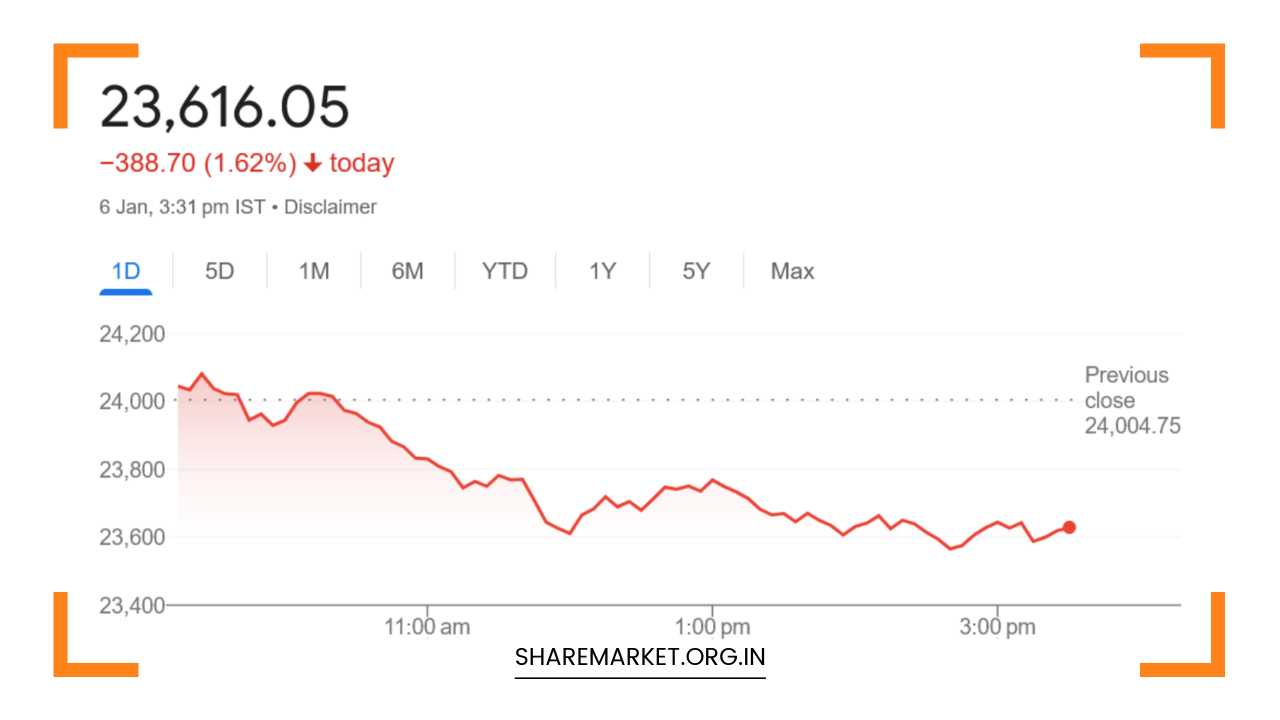Sensex Down 1,258 Points, Nifty at 77,964; Tomorrow Nifty Prediction

Tomorrow Nifty Prediction
Sensex-Nifty End 1.5% Lower: What to Expect for January 7 Amid Market Volatility
Market Overview: Indian stock markets faced significant turbulence on January 6, as investor sentiment soured, leading both the Sensex and Nifty to close down by about 1.5%.
The benchmark indices suffered a sharp decline after a relatively positive start to the trading day, primarily driven by renewed concerns over the potential spread of the Human Metapneumo Virus (HMPV).
Although global market cues remained weak, it was the growing anxiety surrounding the virus, particularly following the confirmation of its first case in India, that pushed investors to sell-off stocks.
At the close of trading, the Sensex dropped 1,258.12 points, or 1.59%, to finish at 77,964.99, while the Nifty ended at 23,616.05, down 388.70 points, or 1.62%.
The broader market saw even more intense selling, with mid-cap and small-cap stocks hit especially hard.
Most sectors ended in the red, and the PSU Bank index was particularly hammered, dropping nearly 4%, after disappointing quarterly results from some of the major public sector banks. The broader market’s lackluster performance reflected a market mood of caution and uncertainty.
Key Factors Behind the Market Decline:
Several factors contributed to the market’s decline on January 6, with the primary driver being the rise in fear over the HMPV outbreak.
This new respiratory virus, which has surfaced amid an ongoing flu season, has raised concerns about the potential for a health crisis, especially after the virus was confirmed in India.
While the Union Health Ministry has assured the public that it is prepared to handle any potential outbreak, the uncertainty surrounding the spread of the virus weighed heavily on investor sentiment.
According to Aditya Gaggar, Director at Progressive Shares, the market’s drop was primarily linked to the negative news surrounding the virus.
Investors rushed to liquidate positions, especially in sectors that are more sensitive to economic disruptions, such as travel, tourism, and public services. As the day progressed, the selling pressure intensified, dragging all sectors into the red.
Mid and small-cap stocks, which are typically more volatile, were particularly vulnerable, leading to a more severe underperformance relative to the frontline indices.
In addition to the domestic concerns regarding the HMPV virus, broader global economic factors also played a role in market sentiment.
Geopolitical risks, along with ongoing worries about global inflation and tightening monetary policies in key economies, added to the negative mood.
With the market already in a fragile state, any negative news could trigger a sharper reaction, as was evident in today’s trade.
Sector Performance:
- PSU Banks: As mentioned, the PSU Bank index saw the largest drop on January 6, falling nearly 4%. This decline was primarily driven by disappointing quarterly earnings from some of the major state-owned banks, raising concerns about the health of the banking sector. Investors appear increasingly wary of state-run financial institutions due to concerns about asset quality and slow credit growth.
- Energy Stocks: Energy stocks also experienced considerable pressure, as rising concerns about a global slowdown led to a decline in crude oil prices. This, in turn, affected the outlook for oil and gas companies, especially those heavily reliant on international prices.
- Mid and Small-Cap Stocks: The broader market suffered as mid-cap and small-cap stocks, typically more sensitive to market volatility, were sold off heavily. Many investors, especially retail participants, tend to gravitate toward these stocks in a rising market but flee at the first signs of trouble, further exacerbating their decline.
- Defensive Sectors: On the other hand, defensive sectors like healthcare, consumer goods, and IT performed relatively better. Stocks like Apollo Hospitals, Tata Consumer, Titan, and HCL Technologies saw gains even as the market languished in the red. This suggests that investors are rotating into safer, non-cyclical sectors amidst the heightened uncertainty.
Technical Analysis and Market Prediction:
From a technical standpoint, the Nifty’s daily chart paints a concerning picture. A strong bearish candlestick formed on the chart, signaling a continuation of the downward momentum.
The index is approaching a crucial support zone between 23,260 and 23,460, which represents a key level from previous market pullbacks.
If the Nifty fails to hold above this range, it could see further declines toward the next support levels.
On the upside, the resistance for the Nifty is pegged at 23,900. Any upward movement is likely to face stiff resistance around this level, which suggests that the market may struggle to regain its footing in the short term.
For the Sensex, the next crucial support is around 77,500-77,800, and resistance lies near 79,500. The near-term outlook remains bearish unless there is a clear catalyst to reverse the current sentiment.
Market Sentiment and Virus Concerns:
The primary risk factor in the short term remains the evolving situation surrounding the HMPV virus.
While the first reported case of the virus in India has heightened concern, it is still too early to determine how the situation will unfold.
The Union Health Ministry has taken proactive measures to control the spread of respiratory illnesses, but the market is likely to remain jittery until there is greater clarity.
Nirav Karkera, Head of Research at Fisdom, noted that while the spread of HMPV has raised alarm bells, the market reaction could be short-lived if the situation is contained.
He believes that any negative reaction from the market may be limited to a knee-jerk response, especially if there are no widespread outbreaks.
However, if the virus spreads significantly, or if there are other external shocks such as geopolitical tensions or adverse economic data, the downside risks could increase.
What to Expect on January 7:
Looking ahead to January 7, the market is likely to continue reflecting caution in light of the ongoing concerns over the HMPV virus.
The immediate support zone for the Nifty remains between 23,260 and 23,460, and if this range holds, the market could stabilize or attempt a modest recovery.
However, any sustained breach below this support zone could see the index testing further lows, with the next significant support level around 23,000.
On the upside, resistance at 23,900 will likely be a significant barrier for any potential recovery. Given the weak global cues and domestic concerns, a strong upward movement seems unlikely unless there is positive news related to the virus or a broader market catalyst emerges.
Investors are advised to stay cautious and monitor developments related to the HMPV situation closely. In the absence of fresh, negative news, a limited decline or sideways movement is expected in the near term.
However, any significant escalation of the virus outbreak or unexpected global economic shocks could lead to a more pronounced market correction.
Final Remarks:
The Indian stock market has entered a period of heightened volatility, driven by both domestic health concerns and global economic risks.
While the immediate outlook is uncertain, investors are advised to adopt a wait-and-watch approach, carefully monitoring key support and resistance levels.
Given the bearish technical signals and the uncertainty surrounding the virus, the market is likely to remain on edge, and investors should prepare for potential further volatility in the coming days.

















